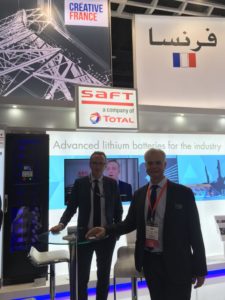High-ambient conditions necessitate air conditioning to ensure lifecycle in critical applications
Dubai, UAE, 17 March 2019: Given the impact of high temperatures on the lifetime of lithium-ion batteries, there is reluctance among stakeholders in the Middle East’s utility and oil & gas sectors to adopt them, said Nick Finney, Li-ion Product and Business Development Manager, Industrial Standby Division, Saft, a company of Total. “They see excursions of 40 or 50 degrees C during the year, and nickel products thrive in that kind of environment,” he said. “Certain applications in the Middle East will stay with nickel-cadmium for many years, because if you use lithium-ion, you need to protect it, and you have to put HVAC.” While lithium-ion can operate in warmer environments, Finney said, to achieve the expected lifetime, there is a need for some sort of air conditioning, once temperatures reach 30 degrees C. “For our lithium-ion for data centres or industrial applications,” he said. “the baseline is 20 years life for 20 degrees C, 16 years for 25 degrees C and about 12 years life for 30 degrees C.”

Saft representatives during the company’s participation in Middle East Electricity, in Dubai.
Despite these considerations, Finney confirmed that there are lithium-ion applications in the region, mostly in hospitals and data centres, where reliability is crucial. Providing the example of data centres, Finney said that for businesses selling through the Internet, operations per second could amount to USD 50,000-100,000. Every second of downtime, he stressed, is lost revenue that cannot be regained. As such, he said that cooling for data centres is the most severe parameter being looked at today in terms of operation, because about 30% of the energy is from cooling equipment.
Finney said that in data centre-type infrastructure, cost associated with space is also crucial. “If it is in the middle of a field in the US, you are perhaps looking at USD 10,000-15,000 dollars per square metre,” he said. “But if you are on the eighth floor in midtown Manhattan, you might be looking at 8-10 times that. Maybe USD 100,000-120,000 dollars per square metre, or higher, so every square metre has a direct impact.” This, he said, makes a case for lithium-ion batteries, which when compared to VRLA, is between two and three times lower in square metre area and lighter. “As you go up in floors and you take the battery higher, the weight becomes even more critical, because the difference between lithium and lead is somewhere round eight times lighter,” he said. “They have to put more steel on to the building and the floor to carry that weight, and we talk about individual batteries that could 30-60 tonnes, so 3-5 times the cost of the extra steel to carry the weight of the lead can be higher cost than the entire lithium.”
Finney said he foresees tremendous growth for data centre requirements in the next 10-15 years and that there is a place for lithium-ion applications. For such applications, he said, it is important to take the initial cost of the air conditioning system and add to it the price of the battery to see the total cost of ownership. The onus, Finney said, must come from the manufacturers to properly educate the market and, as in the case with Saft, to innovate and offer smarter solutions for battery customers of critical applications who are concerned with reducing downtime. This he said, is what drove the company to ensure connectivity across its offerings to drive confidence in performance and to have higher levels of safety.
Hannah Jo Uy is Assistant Editor at Climate Control Middle East magazine. She may be contacted at hannah@cpi-industry.com
Copyright © 2006-2025 - CPI Industry. All rights reserved.